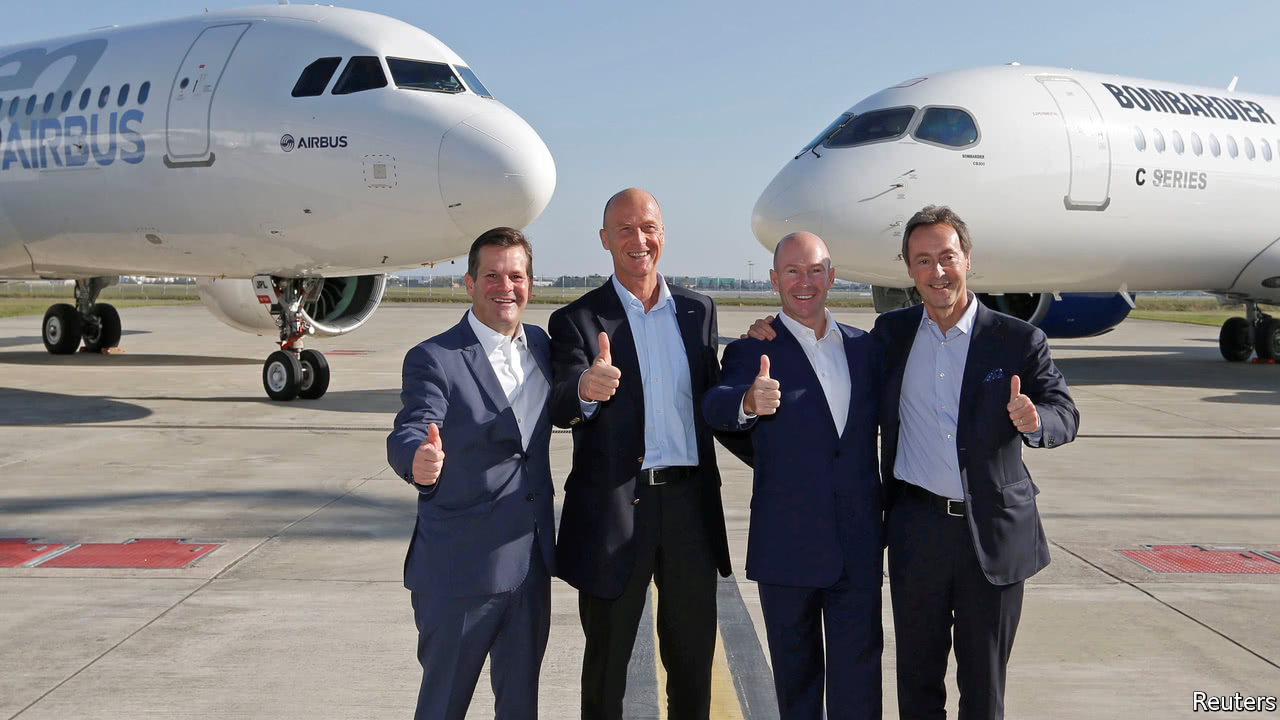
LIKE an airliner in service, Bombardier’s C-Series programme has had multiple highs and lows. In 2008 the Canadian firm began its attempt to break Airbus and Boeing’s duopoly on smaller jets, spooking the pair into upgrading their own models. Costs and delays pushed it near bankruptcy in 2015, followed by a bail-out from the Quebec government worth C$2.8bn ($2.2bn). The next year an order for 75 C-Series jets from Delta, the world’s third-biggest carrier, kept the programme aloft. But decisions in September and October by America’s Commerce Department to agree to demands by Boeing, an aerospace giant, to impose a total tariff of 300% on importing those planes into America risked the C-Series project crashing once and for all.
On October 16th came a surprise surge. Bombardier said it would hand over half the project to Airbus, a European aerospace firm, free of charge. Bombardier and Investissement Québec, the province’s investment arm, will own about 31% and 19% respectively. Aviation Week, a trade journal, called it “the deal of the century”. For Bombardier, whose shares rose 16% on news of the deal, it rescued the C-Series from a premature demise, and pulled the firm clear of a financial cliff.
-
The flow of Rohingya refugees into Bangladesh shows no sign of abating
-
A better way to search through scientific papers
-
Germany’s coalition talks begin
-
Not just another film about Jane Goodall
-
Private jets are getting cheaper
-
Retail sales, producer prices, wages and exchange rates
Airbus had first looked at buying into the C-Series in 2015 but did not invest, worried about the technical risks in its development. But now the C-Series is in service, so the tie-up makes more sense. Bombardier, for its part, lacked sales expertise for big jets or a global maintenance network, which was putting off buyers, but Airbus thinks it can fix these problems by sharing its marketing skills and servicing system.
The latter’s shares rose by 5% this week—Airbus now owns a controlling stake in a new aircraft, admired for its fuel efficiency, for which most development costs have already been paid. “This is a win-win-win situation for everyone”, crowed Airbus’s chief executive, Tom Enders. But not for Boeing, Airbus’s arch-rival. The deal is aimed at sidestepping the tariff imposed at the American firm’s behest. Airbus plans to assemble Delta’s jets—half the components of which are American—at its existing factory in Alabama. It hopes that will result in the C-Series being classed as a domestic product.
But overturning the tariffs may be easier said than done. Jennifer Hillman of Georgetown University, who was a commissioner at America’s International Trade Commission (USITC), thinks that the deal comes too late to affect the decision to impose anti-dumping or anti-subsidy duties against the C-Series (although the USITC may strike down the duties anyway). Boeing has insisted that any duties should be “paid on any imported C-Series airplane or part”. It could also argue that not enough value was added in assembly, and that Airbus therefore should still face the duties. Airbus and Bombardier’s manoeuvre “looks like a questionable deal between two heavily state-subsidised competitors to skirt the recent findings of the US government”, Boeing said.
It is right to fear the new combination. Although Airbus has lost ground in “widebody” jets recently as it refreshes its range, the European giant has already grabbed half the market for “narrowbodies” such as the C-Series. Analysts think the tie-up will further tighten Airbus’s grip. Boeing may now have to spend tens of billions of dollars launching a new narrowbody jet to compete, much sooner than planned.
And by pushing for tariffs on the C-Series, Boeing has annoyed customers, from Delta to the governments of Canada and Britain, which are threatening to tear up future military contracts. News of the tie-up was greeted warmly not only in Canada but also in Northern Ireland, where the C-Series’ wings are made. The Democratic Unionist Party, the province’s largest party, which supports the government of Theresa May, the British prime minister, said it was “thrilled” with the deal.
For Boeing, “the wounds are self-inflicted”, says Adam Pilarski, the former chief economist of McDonnell-Douglas, now part of Boeing. If Boeing had let the Canadian minnow alone, after all, the C-Series would probably have sold only 300 or so planes. But now Boeing’s tariffs have destroyed the C-Series’ value and handed it to its rival for free. Airbus wants to sell up to 6,000 of the planes over the next 20 years.
The triumph of the “cute little plane”, as Airbus once dismissively dubbed the C-Series, however, should not obscure a more troubling trend, which is the increasing dominance of Airbus and Boeing in aerospace. Instead of breaking their duopoly, Bombardier was consumed by it.
Source: economist
Why Airbus’s tie-up with Bombardier is so damaging for Boeing